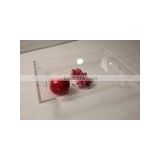Company Name Board Wall Mounted logo Acrylic Signs
Negotiable /Piece
Min.Order:2000 Pieces
Quick Details View All >
Shenzhen Vanjin Craftwork Co., Ltd.
Product Details
Company Name Board Wall Mounted logo Acrylic Signs
For more Acrylic Signs please click here!
Company profile:
Established in 2005, our company and factory are located in Shenzhen.owned customes distubuted in Euopean ,south American , North Amercian , and any other countries .
The main project of the first manufacturing department is acrylic product, we can handle injecting ,silkscreen printing,sandblasting ,cutting and milling , polishing , bending to shape , spray painting ,precision carving , laser incision and so on technology for advertising display. and so on
1. 8 years experiences of professional display manufacturing.
2. serverd several worldwide customers.
3. a capacity of 30,000sets displays per month.
Our factory:


Our showroom:
Q: What is acrylic made of?
A: Acrylic is a transparent thermoplastic known as polyacrylate and is derived from natural-gas. It is a composition of Methyl Methacrylate (MMA) and Poly Methyl Methacrylate (PMMA) resin. In short, it’s a petroleum-based product, so petroleum solvents and chemicals should always be avoided to prevent marking the surface.
Q: What is the difference between acrylic, Plexiglas, Lucite, Perspex, and Lexan or clear plastic?
A: Acrylic (polyacrylate) is marketed under many trade names including Plexiglas, Lucite, Perspex, Policril, Gavrieli, Vitroflex, Limacryl, R-Cast, Per-Clax, Plazcryl, Acrylex, Acrylite, Acrylplast, Altuglas, Polycast, Oroglass, Optix.
These differ from Lexan which is polycarbonate, and is sometimes used as bullet-proof glass. Although it is more shatter-resistant, it is more expensive than acrylic, yellows with prolonged exposure to sunlight, and is much more easily scratched. Therefore acrylic is more ideal for most interior and exterior design purposes.
Clear plastic can refer to a wide range of synthetic compounds, with varying strengths, melting points, and other properties.
Q: How do I clean acrylic?
A: Acrylic care consists of no more than normal wipe-cleaning to keep it looking new. Chemicals should never be used, and care should be taken to avoid scratches. Use a mild soap & water mixture with a gentle cleaning cloth. Do not use ammonia based cleaning solutions on the acrylic as it will eat into the sheet and cause it to craze.
Q: How can I remove scratches from acrylic?
A: Removing acrylic scratches (ones that you can see or feel by passing a fingernail over them) can be accomplished by using Novus2 or Novus3 cleaner, depending on the severity of the scratch. These are available on our Product Care page.
Q: Will acrylic melt?
A: While acrylic softens at higher temperatures, it does not actually melt until it reaches 320 °F (160 °C). Therefore, normal household use does not risk melting acrylic. Hot stovetop items should only be placed on an acrylic tabletop surface using a protective trivet or other padding, preferably with rubber cushions. As a safety precaution, never place acrylic directly on or next to an open flame or hot surface.
Q: Should I keep acrylic out of the sun?
A: No, sunlight will not affect your acrylic items. All plastics come from petroleum and natural gas. Sunlight, especially ultraviolet radiation, has a disastrous effect on most plastics. This is why many children’s toys become brittle and crack when left outside. Acrylic is derived from natural gas and is completely inert in its solid form and will NOT yellow in the sunlight.
Q: Is acrylic the same as “bullet-proof” glass?
A: No, bullet-resistant glass is made from polycarbonate. Trade names for the base material include Armormax, Makroclear, Cyrolon, Lexan and Tuffak. Although it is more shatter-resistant, polycarbonate is more expensive than acrylic, yellows with prolonged exposure to sunlight, and is much more easily scratched. Therefore acrylic is the far better material for most interior and exterior design purposes.
Q: Can acrylic be painted?
A: Yes, you can paint acrylic using, obviously, acrylic paint, inkjet, silkscreen or Laser Engraved.
Q: Does acrylic ‘outgas’ or can it be toxicologically harmful?
A: No – when used for as directed and in ambient temperatures, acrylic does not pose hazardous nor toxicological effects to health. This material has been classified as non-hazardous under OSHA regulations.
Contact Supplier

You May Like


New Products
Popular Searches
Recommended Products
Find Similar Products By Category